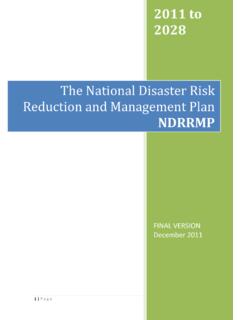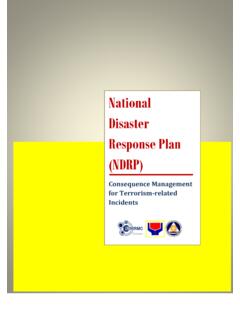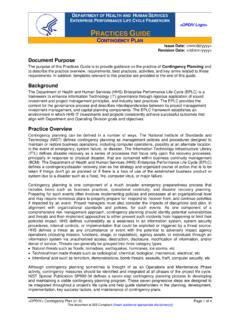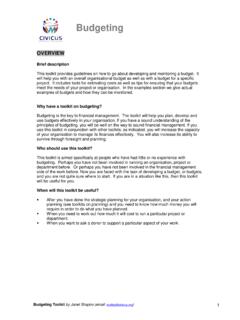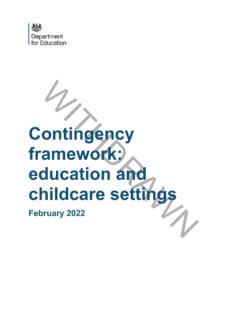Transcription of Inertia and the Power Grid: A Guide Without the Spin - NREL
1 Inertia and the Power Grid: A Guide Without the Spin Paul Denholm,1 Trieu Mai,1 Rick Wallace Kenyon,2. Ben Kroposki,1 and Mark O'Malley1. 1. national Renewable Energy Laboratory 2. University of Colorado Boulder nrel is a national laboratory of the Department of Energy Technical Report Office of Energy Efficiency & Renewable Energy nrel /TP-6A20-73856. Operated by the Alliance for Sustainable Energy, LLC May 2020. This report is available at no cost from the national Renewable Energy Laboratory ( nrel ) at Contract No. DE-AC36-08GO28308. Inertia and the Power Grid: A Guide Without the Spin Paul Denholm,1 Trieu Mai,1 Rick Wallace Kenyon,2.
2 Ben Kroposki,1 and Mark O'Malley1. 1. national Renewable Energy Laboratory 2. University of Colorado Boulder Suggested Citation Denholm, Paul, Trieu Mai, Rick Wallace Kenyon, Ben Kroposki, and Mark O'Malley. 2020. Inertia and the Power Grid: A Guide Without the Spin. Golden, CO: national Renewable Energy Laboratory. nrel /TP-6120-73856. nrel is a national laboratory of the Department of Energy Technical Report Office of Energy Efficiency & Renewable Energy nrel /TP-6A20-73856. Operated by the Alliance for Sustainable Energy, LLC May 2020. This report is available at no cost from the national Renewable Energy national Renewable Energy Laboratory Laboratory ( nrel ) at 15013 Denver West Parkway Golden, CO 80401.
3 Contract No. DE-AC36-08GO28308 303-275-3000 NOTICE. This work was authored by the national Renewable Energy Laboratory, operated by Alliance for Sustainable Energy, LLC, for the Department of Energy (DOE) under Contract No. DE-AC36-08GO28308. Funding provided by GridLab. The views expressed herein do not necessarily represent the views of the DOE or the Government. This report is available at no cost from the national Renewable Energy Laboratory ( nrel ) at Department of Energy (DOE) reports produced after 1991. and a growing number of pre-1991 documents are available free via Cover Photo by Dennis Schroeder: nrel 50710.
4 nrel prints on paper that contains recycled content. Acknowledgments The authors would like to thank the following individuals for their contributions. Editing and graphics support were provided by Devonie McCamey, Mike Meshek, Besiki Kazaishvili, and Joshua Bauer. Billy Roberts created the map. Helpful review and comments were provided by Mark Ahlstrom, Doug Arent, Sam Baldwin, Aaron Bloom, Jaquelin Cochran, Vahan Gevorgian, Patrick Gilman, Himanshu Jain, Julia Matevosjana, and Ric O'Connell. This work was inspired in part by conversations with Debbie Lew. Finally, we gratefully acknowledge funding for this work from GridLab.
5 This work was authored by the national Renewable Energy Laboratory, operated by Alliance for Sustainable Energy, LLC, for the Department of Energy under Contract No. DE-AC36-08GO28308. The views expressed in the article do not necessarily represent the views of the DOE or the Government. The Government retains a nonexclusive, paid-up, irrevocable, worldwide license to publish or reproduce the published form of this work, or allow others to do so, for Government purposes. iii This report is available at no cost from the national Renewable Energy Laboratory at List of Acronyms and Abbreviations AC alternating current DC direct current DOE Department of Energy EI Eastern Interconnection ERCOT Electric Reliability Council of Texas FERC Federal Energy Regulatory Commission FFR fast frequency response GW gigawatt GWh gigawatt-hour GW s gigawatt-second IBR inverter-based resource kW kilowatt kWh kilowatt-hour LR load response MISO Midcontinent Independent System Operator mph miles per hour MW megawatt MWh megawatt-hour MW s megawatt-second
6 NERC North American Electric Reliability Corporation nrel national Renewable Energy Laboratory PFR primary frequency response RPS rotations per second PV photovoltaics RoCoF rate of change of frequency RRS responsive reserve service UFLS underfrequency load shedding VG variable generation WI Western Interconnection iv This report is available at no cost from the national Renewable Energy Laboratory at Executive Summary Inertia in Power systems refers to the energy stored in large rotating generators and some industrial motors, which gives them the tendency to remain rotating.
7 This stored energy can be particularly valuable when a large Power plant fails, as it can temporarily make up for the Power lost from the failed generator. This temporary response which is typically available for a few seconds allows the mechanical systems that control most Power plants time to detect and respond to the failure. Historically, in the Power grid, Inertia from conventional fossil, nuclear, and hydropower generators was abundant and thus taken for granted in the planning and operations of the system. But as the grid evolves with increasing penetrations of inverter-based resources , wind, solar photovoltaics, and battery storage that do not inherently provide Inertia , questions have emerged about the need for Inertia and its role in the future grid.
8 Intended to educate policymakers and other interested stakeholders, this report provides an overview of Inertia 's role in maintaining a reliable Power system, why Inertia may decrease with increasing deployment of wind and solar generation, and how system reliability can be maintained in the evolving grid. An accompanying video ( ) further illustrates several key concepts. Key takeaways from the full report include: 1. Grid frequency, which is a measure of the balance of supply of electricity and demand, can drop if a large Power plant or transmission fails. Inertia resists this drop in frequency, giving the grid time to rebalance supply and demand.
9 2. Inertia is only one of several grid services that help maintain Power system reliability. Understanding the role of Inertia requires understanding the interplay of Inertia and these other services, particularly primary frequency response, which is largely derived from relatively slow-responding mechanical systems. 3. The importance of Inertia to a Power system depends on many factors, including the size of the grid and how quickly generators in the grid can detect and respond to imbalances. A grid with slower generators needs more Inertia to maintain reliability than a grid that can respond quickly.
10 4. Using Power electronics, inverter-based resources including wind, solar, and storage can quickly detect frequency deviations and respond to system imbalances. Tapping into electronic-based resources for this fast frequency response can enable response rates many times faster than traditional mechanical response from conventional generators, thereby reducing the need for Inertia . 5. Replacing conventional generators with inverter-based resources, including wind, solar, and certain types of energy storage, has two counterbalancing effects. First, these resources decrease the amount of Inertia available.










